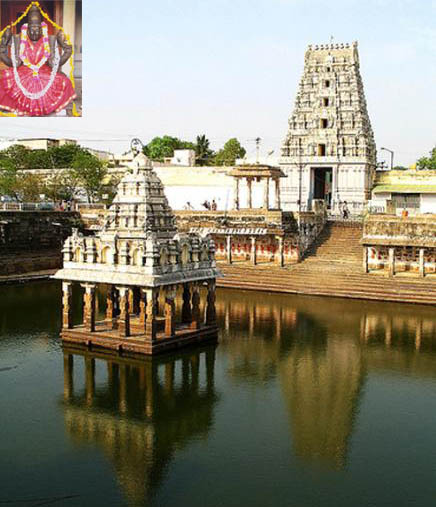Name of the Temple |
|
Location |
- Kānchipuram, near Chennai, Tamilnāḍu.
|
| How to reach there? |
- By Air: The nearest airport is located in Chennai, 62 km. From the airport take the State Highway 48 heading west.
- By Train : Kānchipuram railway station is just 2 km north of the temple.
- By Road : Kānchipuram is connected through the National Highway 4 from Puṇe to Chennai.
|
Rulers/builders and Time Period |
- The temple was most probably built by the Pallava kings , whose capital was Kānchipuram , around 6 C . E .
|
Deity/Deities |
- Kamakṣhi, one of the forms of the goddess Pārvathi.
|
Architecture Style |
- Kāmākṣhi temple is situated at about 5 acres of land and has four entrances.
- The main entrance Kānchi of the temple has a Kālabhairavar deity. On the centre of the entrance you can see a huge Dwajasthamba.
- Moving further to the entrance of the Kāmākṣhi deity you can see a Vināyaka deity. Moving on a straight line further, Goddess Kāmākṣhi is visible. The Goddess also has Vārāhi, Arupalakṣhmi Kaḷvarperumāḷ (one of the 108 Dhivya Desam of Vaiṣhṇavities), Rūpalakṣhmi and Ardhhanāriśhwarar deities surrounding the sanctorum of Goddess on its Gāyathri Mantapam.
- There is Santhānasthambam inside the prakāram of Goddess which is called the Nābhisthan of the Goddess. There is a Śhrīchakra Yanthra (Śhrī Kāmakoṭi Pītam) established by Jagadhguru Śri Ādhi Śhankaracharya in front of the Goddess deity. There is also a temple tank inside the premises
|
Other Special Features |
- Though there are many temples in this city with Shiva as the main deity, the only temple to have Kāmākṣh(Pārvathi) as the main the goddess is this.
- There are 51 Śhakti Pīṭhas across the country. The goddess residing place in Kānchi is called as “Nābisthhāna Ottiyana Pīṭham”.
- The Goddess is called as “Śhri Kāmākṣhi . The word is derived from the heritage “Kā” means Goddess Saraswathi (God of Education), “Mā” means Goddess Lakṣhmi (God of Wealth), “Akṣhi” means Eye. The name as a whole refers as the god lives in Kānchi with Goddess Saraswathi and Goddess Lakṣhmi as her both eyes.
- The special occasions for the Goddess Kāmākṣhi are Navarāthri, Bhramothsavam and Pourṇami (Full Moon Day). The goddess is distinctively powerful in these times and it is even more auspicious to visit the temple in these days
|
Special Reference to Performing Arts |
- Sundaramūrthi Nāyanār, the Śhaiva saint of the 12th century is aware of the Kāmakoṭṭam. He in fact mentions that the Kāmakoṭṭam has come in existence just at that time. The history reveals us that King Daśharatha performed “Puthra Kāmeśhṭi Yāgam” in the temple and the extract of this story is visible in “Markanḍeya Purāṇam”.
- To personify Kāmākṣhi, Ādhi Śhankarāchārya sung songs in the praise of goddess named “Soundarya Lahari” then he established a Śhrī Chakra in front of her idol to keep her cool and personified.
- The temple was visited by a dumb devotee named “Mūkan”. The goddess provides him grace by freeing him from dumbness and he wrote a poetry named “Mūkapanchaśhathi” in which he praises entirely about the grace of the goddess with her beauty.
- Gīrvaṇendhra Saraswathi describes precisely this swarūpa as Kāmeśhwari.
- The most famous Swarajathis composed by Shyama shastri are on Kāmākṣhi. They are in Rāgas Thoḍi, Bhhairavi and Yadhukula kāmbodhi.
- Muthuswāmi Dīkṣhithar lived in Kānchi for a few years. During that time, he composed several krithis on Kāmākṣhi. (listed down)
|
Bibliography |
|















